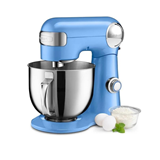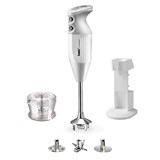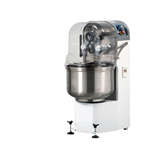Key Takeaways
For artisan bakeries, pizzerias, and patisseries in Australia needing the essential facts on fork mixers, here are the critical insights for your 2025 purchase:
- Gentle Mixing, Superior Dough: Fork mixers are prized for their gentle, folding action that mimics hand-kneading. This minimises friction and keeps dough temperatures low, which is crucial for developing the complex flavours in artisan breads, ciabatta, and high-hydration doughs.
- Price Range: Expect to invest between $7,000 to over $15,000 for a quality commercial fork mixer in Australia. Models with larger capacity, 3-phase power, and two speeds will be at the higher end of this range.
- Fork vs. Spiral Mixer: A fork mixer is for the artisan who prioritises dough quality and temperature control over speed. A spiral mixer is faster and more versatile for a wider range of doughs but generates more heat, which can be detrimental to delicate, long-fermentation recipes.
- Capacity is Key: Capacity is measured in kilograms of finished dough. A 40L bowl will typically handle about 35kg of finished dough. Ensure the machine's capacity matches your batch size to avoid overloading the motor.
- Australian Compliance: Ensure any mixer complies with Australian electrical safety standards. All equipment must be safe to use and properly tagged. For food safety, the mixer must be constructed from food-grade materials and be easy to clean to comply with HACCP principles.
- Financing Your Mixer: A Chattel Mortgage is often the most effective financing option for Australian businesses. It allows you to take immediate ownership, claim the GST on the purchase price upfront, and deduct interest and depreciation as business expenses.
Your 2025 Buying Guide to Commercial Fork Mixers in Australia
In the world of artisan baking, the quality of your dough is everything. While spiral mixers are the undisputed workhorses of many high-volume bakeries, the fork mixer holds a revered place in kitchens where tradition, temperature control, and the delicate handling of dough are paramount. Its unique, gentle mixing action is the secret behind the open, airy crumb of a perfect ciabatta and the complex flavour of a slow-fermented sourdough.
Choosing to invest in a fork mixer is a commitment to a specific style of baking. But with a significant price tag and technical differences from other machines, it's a decision that requires careful consideration.
This detailed guide will walk you through the key differences between fork and spiral mixers, what to look for in a machine, realistic price expectations, and the compliance standards you need to meet in Australia.
Fork Mixer vs. Spiral Mixer: What's the Difference?
Your choice of mixer will fundamentally impact your final product.
Fork Mixer: The Artisan's Choice
A fork mixer uses a gentle, sweeping, and lifting motion with its two-pronged fork, closely replicating the delicate process of kneading by hand.
- Key Advantage: Low Friction, Low Heat. This is the number one reason to choose a fork mixer. The slow, gentle action generates very little friction, keeping the dough cool. This is essential for long-fermentation doughs where premature yeast activation due to heat can ruin the final product.
- Excellent Oxygenation: The lifting and folding motion is incredibly effective at oxygenating the dough, which helps develop a strong gluten network without overworking it.
- Best for: High-hydration doughs (ciabatta, focaccia), traditional French baguettes, sourdough, and enriched doughs like panettone and brioche.
- Drawbacks: Mixing times are longer compared to a spiral mixer, and they are generally less effective for very stiff, low-hydration doughs.
Spiral Mixer: The All-Round Powerhouse
A spiral mixer uses a spiral-shaped hook that rotates while the bowl also spins, creating a fast and powerful kneading action.
- Key Advantage: Speed and Versatility. A spiral mixer can develop a strong gluten structure in a fraction of the time it takes a fork mixer. It can handle a wide variety of dough types, from stiff bagel dough to softer pizza dough.
- Drawbacks: The high speed generates more friction and heat, which requires the baker to carefully manage dough temperature, often by using chilled water. The intense action can be too harsh for very delicate or high-hydration doughs.
Price Points & Key Features
Fork mixers are specialised pieces of equipment, and their pricing reflects their robust construction.
- Small Capacity (25-35kg dough): Expect to pay between $7,000 and $9,500. These models are often single-speed and run on single-phase power, making them a good entry point.
- Medium Capacity (35-80kg dough): This is the most common range for small to medium-sized bakeries, with prices from $9,500 to over $15,000. These machines are typically 3-phase with two speeds for greater control.
Key Operational Features to Look For
- Fixed vs. Removable Bowl: Fixed bowls are more common and offer greater stability. Removable bowls make cleaning and dough extraction significantly easier but come at a premium price.
- Two-Speed Motor: A two-speed motor is highly desirable. The first, slower speed is used to gently combine the ingredients, while the second, faster speed is used for gluten development. This feature is standard on most 3-phase models.
- Build Quality: Look for a heavy-duty stainless steel frame, bowl, and fork. The machine should be heavy to ensure it remains stable when mixing large, heavy batches of dough. All rotating parts should be on ball bearings to reduce noise and wear.
- Safety Guard: A stainless steel bowl guard is a mandatory safety feature that will stop the machine immediately when lifted.
Australian Compliance & Certification
Ensuring your equipment is safe and compliant is a legal requirement.
- Electrical Safety: All commercial kitchen equipment must comply with Australian electrical safety standards. The machine should be tested and tagged by a qualified technician upon installation to ensure it is safe to operate.
- HACCP & Food Safety: To comply with food safety standards, your fork mixer must be made from food-grade materials (like stainless steel) and be designed for easy cleaning. Smooth surfaces and minimal crevices prevent the build-up of old dough and bacteria.
Common Questions from Buyers
Q1: What is the ideal hydration level for a fork mixer?
Fork mixers excel with dough hydration levels of 60% and above. They are particularly effective for artisan doughs in the 70-85% hydration range, where a gentle touch is needed to build strength without turning the dough into a sticky mess.
Q2: Can I make pizza dough in a fork mixer?
Yes, you can make excellent pizza dough in a fork mixer, especially for styles like Neapolitan or Roman that benefit from a delicate structure and good oxygenation. However, for very large volumes of standard pizza dough, a spiral mixer is often more time-efficient.
Q3: How do I clean and maintain a fork mixer?
Daily cleaning is simple but vital. After use, disconnect the power, scrape down any excess dough, and wipe the bowl, fork, and body with a damp cloth and a food-safe sanitiser. It's recommended to have the mixer professionally serviced annually to check belts, bearings, and electrical components.
Final thoughts: Choosing the right fork mixer for your bakery
Investing in a commercial fork mixer is more than just purchasing equipment; it is a commitment to artisan quality, precision, and consistency in your baking. For Australian bakeries, pizzerias, and patisseries, a fork mixer allows you to achieve gentle, low-heat kneading, producing dough with superior flavour, texture, and structure that your customers will notice.
While the upfront cost may be higher than standard mixers, the benefits, from perfectly oxygenated high-hydration doughs to compliance with Australian electrical and food safety standards, make it a smart, long-term investment. By carefully considering capacity, motor speed, build quality, and operational features, and by pairing the purchase with a suitable finance solution like a Chattel Mortgage, you can align your bakery’s operational needs with its financial strategy.
Ultimately, the right fork mixer is not just a tool; it is an extension of your craft. Selecting the model that fits your bakery’s volume, style, and workflow ensures every loaf, pizza, or pastry meets the high standards of artisan baking and sets your business up for success in 2025 and beyond.


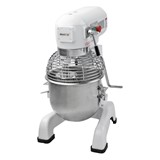
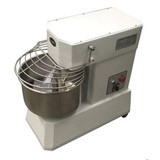

-160x160-state_article-rel-cat.png)


